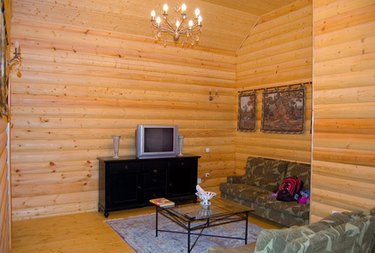
When you play an acoustic guitar, the strings resonate over the soundhole, which causes sound waves to bounce around inside the body of the guitar and vibrate the top of the guitar at the same frequencies as the strings. Rooms resonate in the same way. When designing or re-designing a room, reducing the resonant frequency allows you to better hear conversations without echoes and listen to entertainment center audio without interference.
After Room Construction
Video of the Day
Step 1
Measure the dimensions of the room. Use your tape measure to measure the room in feet.
Video of the Day
Step 2
Write down the longest dimension for the room, then double it. When calculating the resonant frequency of a room, you will need to double the longest dimension because when sound travels along that route, it will bounce back and cover the same distance again.
For example, if the longest room dimension was 11.3 feet, double that would be 22.6 feet. In the calculation for frequency, this fulfills the component for the wavelength in the equation, which is also provided by Sengpiel Audio's web site.
Step 3
Divide 1,130 feet per second, which is the speed of sound, by the figure from Step 2, where you doubled the longest dimension of a room. This will give you the first mode (in Hertz) for the resonant frequency.
Back to the example from the previous step: 1,130 feet per second divided by 22.6 feet equals 50 Hertz (the first mode). Basically, you are doing a calculation for frequency (Hertz) by dividing the wave speed (1,130 feet per second) by the wave length (twice the longest dimension of the room). As long as the measurement for the room is done in feet, then the calculation automatically cancels out the feet for both the wave speed and the wave length. This leaves you with the number of cycles that the wave will travel in one second, which is also known as Hertz.
Step 4
Calculate multiples of the first mode until you have reached the tenth mode. For example, if you got 50 Hertz for the first mode of the resonant calculation, then the second mode would be 100 Hertz. The third mode would be 150 Hertz and the fourth 200 Hertz. All of these additional modal frequencies will also resonate because of the ability of a sound wave to continue traveling back and forth between walls.
Step 5
Calculate all other dimensions of the room, so that you have three sets of modes. By the end of the calculations, you should have accounted for the room's length, width, and height. Once you have all three sets of modes, you will have calculated the resonant frequencies of the room.
Before Room Construction
Step 1
Download ModeCalc, which is an acoustic engineering program that measures the modes and different resonant frequencies of a room. The computations used by this program are similar to the method described above, but much more advanced and complicated.
Step 2
Plug in the numbers for the room's dimensions to the ModeCalc. Follow the directions at the top of the screen of the ModeCalc application to enter the room dimensions.
Step 3
Study your result and, if possible, change the dimensions of your room. ModeCalc will give you a graphical representation of the first ten modes for each room dimension, allowing you to see "where they occur and how they interact with each other," according to Audioholics.